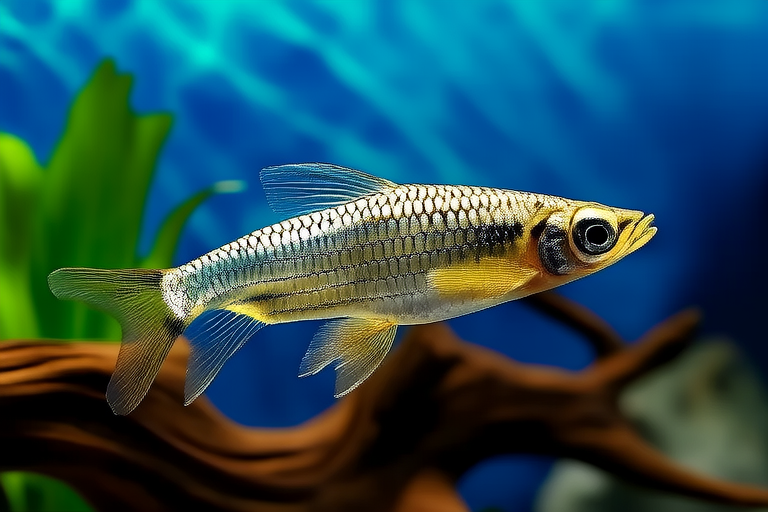A Look into the Glittering World of Exotic Pets: The Arowana
The world of exotic pets is a fascinating realm, filled with creatures that captivate our imagination and curiosity. Among these, the arowana stands out as a particularly mesmerizing choice. Known for its striking appearance, regal demeanor, and unique behaviors, the arowana is a fish that demands attention. This article delves into the glittering world of the arowana, exploring its physical characteristics, natural habitat, dietary needs, care requirements, behavior, and the legal and ethical considerations involved in owning one.
Physical Characteristics
The arowana is a large, sleek fish that can grow up to three feet in length. It boasts a distinctive appearance characterized by its elongated body and long dorsal and anal fins. These features give the arowana an almost prehistoric look, contributing to its allure. Its scales are large and shiny, reflecting light in a way that resembles the shimmer of metal, which has earned it the nickname ‘Dragon Fish.’ The coloration of the arowana varies depending on the species; some have silver bodies with black spots, while others display more vibrant hues of green or red.
Natural Habitat
Native to South America, Southeast Asia, and parts of Africa, arowanas thrive in freshwater environments. They prefer slow-moving rivers, floodplains, and swamps where they can find ample cover and food. In the wild, arowanas are top predators, feeding on a variety of prey including insects, small fish, and even birds that venture too close to the water’s surface. Their natural habitat provides them with the conditions necessary for their survival and well-being.
Dietary Needs
In captivity, the arowana’s diet should closely mimic its natural food sources. A balanced diet for a captive arowana typically includes a mix of live foods such as feeder fish, earthworms, and crickets. Some owners also supplement their diet with high-quality pellets designed for carnivorous fish. It’s important to ensure that the food items are appropriately sized for the arowana’s mouth and digestive system. Feeding once or twice daily is usually sufficient, but overfeeding should be avoided to maintain optimal health.
Care Requirements
Owning an arowana requires a significant investment in terms of time, space, and resources. First and foremost, arowanas need a spacious aquarium that can accommodate their size and swimming habits. A tank of at least 250 gallons is recommended for an adult arowana, though larger tanks are preferred. The tank should be equipped with a strong filtration system to handle the waste produced by these large fish. Additionally, arowanas require a stable water temperature between 78-84 degrees Fahrenheit and a pH level of around 6.5-7.5.
Proper lighting is also crucial for the arowana’s well-being. Many owners opt for full-spectrum lighting to simulate natural sunlight and promote healthy growth. Regular maintenance of the tank, including water changes and cleaning, is essential to prevent disease and ensure a clean living environment.
Behavior
Arowanas are known for their intelligence and interactive nature. They often swim near the surface of the water, making them visible and engaging for their owners. Some arowanas have been observed to recognize their caretakers and may even respond to certain stimuli, such as hand-feeding or playtime. However, it’s important to note that arowanas can be territorial and aggressive towards other fish, especially during feeding times. Therefore, it’s best to keep them in a single-species tank to avoid conflicts.
Unique Traits
One of the most remarkable traits of the arowana is its ability to leap out of the water to catch airborne prey. This behavior, known as ‘surface feeding,’ is a testament to the arowana’s evolutionary adaptation. Another unique feature is the presence of a specialized bone structure in its jaw that allows it to extend its mouth like a trapdoor, facilitating the capture of fast-moving prey. These traits highlight the arowana’s agility and adaptability, making it a truly extraordinary creature.
Legal Aspects
The ownership of arowanas is subject to various legal restrictions depending on the country and region. In some areas, arowanas are considered endangered species, and international trade is heavily regulated under the Convention on International Trade in Endangered Species of Wild Fauna and Flora (CITES). In other regions, there may be local laws governing the possession, sale, and transport of these fish. Prospective owners should thoroughly research the legal requirements in their area before considering an arowana as a pet.
Responsibility
Keeping an arowana comes with a great deal of responsibility. Owners must commit to providing a suitable living environment, regular care, and attention. The initial cost of setting up a tank and acquiring an arowana can be substantial, and ongoing expenses for food, equipment, and maintenance should not be overlooked. Furthermore, owners should be prepared to address any health issues that may arise and seek professional advice when necessary. The commitment to caring for an arowana is long-term, and potential owners should consider whether they are willing to meet these responsibilities before bringing one home.
Conclusion
The arowana is a magnificent and unique addition to the world of exotic pets. With its striking appearance, intelligent behavior, and fascinating traits, it offers a rewarding experience for those who are ready to take on the challenge of owning such a remarkable fish. However, prospective owners must be aware of the legal and ethical considerations involved and be fully prepared to provide the care and attention required for a happy and healthy arowana. By doing so, they can enjoy the beauty and wonder of this extraordinary creature for years to come.
